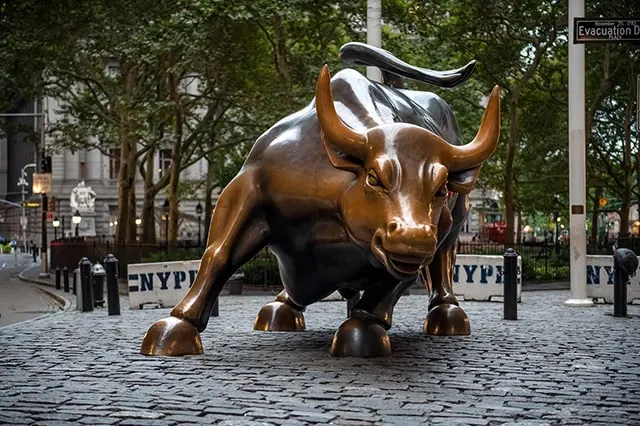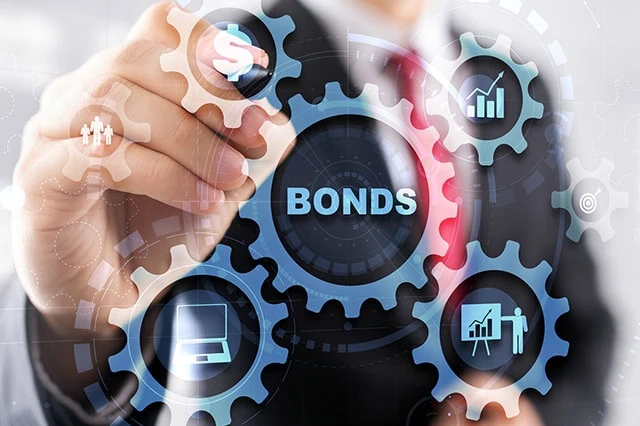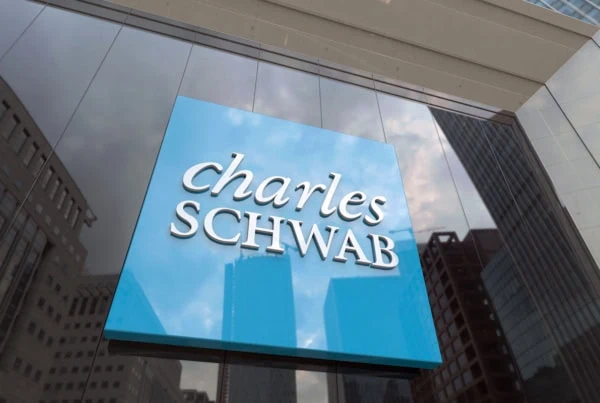Try to find something investors love more than index funds. It’s difficult! Because these simple, automated investments let us have our cake and eat it too. Index funds give us all of the diversification of a standard managed fund, but with the added cost efficiency and simplicity of tracking a rules-based index.
In fact, index funds are now the preferred choice of American investors. The first index fund—what today is the Vanguard 500 Index Fund—launched in 1976. Twenty years later, index funds still represented a single-digit market share of assets across all long-term mutual funds and exchange-traded funds (ETFs) in the U.S., according to Morningstar data. That number grew to 10% by the turn of the century, swelled to nearly 30% by 2015, and at the start of 2024, U.S. index funds’ share of assets finally surpassed actively managed funds for the first time, 50.15% to 49.85%.
Of course, those assets are scattered across literally thousands of products. But unless you’re a billionaire masochist, you’re probably not looking to juggle a few thousand index funds in your portfolio. Indeed, if you’re investing in index funds, you’d likely only need a handful to build yourself an effective portfolio.
Today, I’m going to help simplify your search by providing you with a shortlist of the best index funds you can buy right now. The goal here is to provide you with a variety of options that should fill most investors’ basic needs. (Note: This list is exclusively index mutual funds—but you can find a plethora of great index ETFs in our best ETFs list.)
Disclaimer: This article does not constitute individualized investment advice. These securities appear for your consideration and not as personalized investment recommendations. Act at your own discretion.
How Were the Best Index Funds Selected?

Mutual funds are big business. The Investment Company Institute’s most recent annual Fact Book shows that investors have plowed $25.5 trillion in assets into nearly 8,600 U.S. mutual funds. But that same Fact Book shows the median number of mutual funds that a given household owns is … three.
That means if the average household splits their money between actively managed mutual funds and passively managed index funds, they might only need two index funds … possibly only one. Of course, that’s the average household; some investors might hold a few more.
Regardless, selecting a handful of the best index funds from a universe of thousands is awfully difficult. So I’ve pared that list down to a more digestible group of about 10.
I started my search with a quality screen, including only index funds that have earned a Gold Morningstar Medalist rating. Morningstar has two ratings systems—the Star ratings and the Medalist ratings. The latter are a forward-looking analytical view of a fund. Per Morningstar:
“For actively managed funds, the top three ratings of Gold, Silver, and Bronze all indicate that our analysts expect the rated investment vehicle to produce positive alpha relative to its Morningstar Category index over the long term, meaning a period of at least five years. For passive strategies, the same ratings indicate that we expect the fund to deliver alpha relative to its Morningstar Category index that is above the lesser of the category median or zero over the long term.”
As I’ve written in other Young and the Invested articles, a Medalist rating doesn’t mean Morningstar is necessarily bullish on the underlying asset class or categorization. It’s merely an expression of confidence in the fund compared to its peers.
To narrow the list further, I also required the following:
- No loads: In addition to annual expenses, some funds charge additional fees, including “loads.” For instance, if you invested $10,000 in a mutual fund with a 5% front-end load, the mutual fund company would immediately take $500 out in fees. So, you’d already be starting behind the 8-ball, investing just $9,500 to start with. The funds here have no sales charges.
- Reasonable investment minimums. The maximum investment minimum for inclusion is $3,000, which is the common investment minimum for Vanguard funds. But most of the remaining funds on this list have either no minimum requirement, or a minimum of just $1. Also, some fund providers explicitly lay out lower investment minimums for specific retirement plans, such as individual retirement accounts (IRAs). T. Rowe Price, for instance, has $2,500 minimum initial investments on many of its funds, but lowers that minimum to $1,000 when investing through an IRA.
- Broad availability: Mutual funds commonly have several share classes, many of which are limited to certain types of accounts, like, say, only for 401(k)s or only for wealth management clients. All of the index funds listed here are Investor-class or similar shares that are generally considered to be widely available to retail investors.
From the much more manageable resulting list, I’ve selected a group of index funds that provide a wide array of core and tactical strategies, ensuring there’s at least one fund, if not many funds, for just about everyone.
Do you want to get serious about saving and planning for retirement? Sign up for Retire With Riley, Young and the Invested’s free retirement planning newsletter.
The Best Index Funds to Buy Now

And finally, a few things I’d like to point out before we dig into the funds. None of the following have to do with selection criteria—they’re just other features of the funds you’re about to discover:
- These aren’t just the best index funds you can buy at the moment—in almost every case, they’re either the cheapest such index fund you can buy, or within just a couple of basis points of being the cheapest. (A basis point is one one-hundredth of a percentage point.)
- While these funds have no sales loads, brokerage commission fees might apply; check your brokerage before purchasing.
- Your brokerage might require a larger minimum initial investment for mutual funds than the fund itself requires.
- Some brokerage accounts might not let you purchase certain funds, even if they’re generally available to retail investors. (For instance, you might be able to buy the completely made-up Woodley Investments Large-Cap Fund at Schwab, but not at Fidelity.)
- This isn’t a ranking of the best funds. Every fund on here rates as excellent already. This is just listed in a natural progression of various portfolio needs, starting broadly with different stock flavors and ending with a few bond funds.
- And lastly … you’re about to see a lot of Vanguard and Fidelity. These two firms specialize in low-cost index funds, and I frequently gave their funds the nod over virtually identical products from other providers because their costs were slightly lower—something that, if you look at past returns, has historically contributed to a slight performance advantage.
With all that out of the way, let’s look at the best index funds you can buy.
1. Fidelity 500 Index Fund

- Style: U.S. large-cap stock
- Assets under management: $696.3 billion
- Dividend yield: 1.2%
- Expense ratio: 0.015%, or 15¢ per year for every $1,000 invested
- Minimum initial investment: None
The Fidelity 500 Index Fund (FXAIX) isn’t just one of the best index funds you can buy—it’s the only index fund that made our list of the best mutual funds you can buy.
The S&P 500 Index is commonly used as a performance benchmark for mutual funds that invest in U.S.-based large-cap stocks. But the majority of fund managers who run these funds typically struggle to beat their benchmark. Consider this: According to S&P Dow Jones Indices, in 2024, “65% of all active large-cap U.S. equity funds underperformed the S&P 500, worse than the 60% rate observed in 2023 and slightly above the 64% average annual rate reported over the 24-year history of our SPIVA Scorecards.”
I say to that: If you can’t beat it, join it.
Fidelity 500 Index Fund tracks the S&P 500—a collection of some of the largest American companies, but to clarify, not the 500 largest American companies. To be included in this index, a company must have a market capitalization of at least $20.5 billion, its shares must be highly liquid (shares are frequently bought and sold), and at least 50% of its outstanding shares must be available for public trading, among other criteria. A company must also have positive earnings in the most recent quarter, and the sum of its previous four quarters must be positive—two traits that weed out at least a few massive firms that would otherwise be included.
Note: Once a company becomes an S&P 500 component, it’s not automatically kicked out if it fails to meet all of the criteria. However, the selection committee would take this under consideration and possibly boot the company.
The S&P 500 is considered a reflection of the U.S. economy. But it’s not a perfect representation, nor is the U.S. economy perfectly balanced. To wit? The technology sector accounts for a third of FXAIX’s assets, while real estate, materials, and utilities are weighted at less than 3% apiece. This is in no small part because, like many indexes, the S&P 500 is market capitalization-weighted, which means the greater the size of the company, the more “weight” it’s given in the index. Currently, trillion-dollar-plus companies Nvidia (NVDA), Microsoft (MSFT), and Apple (AAPL) sit atop Fidelity 500 Index Fund’s holdings list.
Turnover, which is how much the fund tends to buy and sell holdings, is always low, given that only a handful of stocks enter or leave the index in any given year. This tamps down (and often eliminates) capital-gains distributions, which receive unfavorable tax treatment. This makes FXAIX an extremely tax-efficient option for taxable brokerage accounts.
Importantly: Fidelity 500 Index Fund is not the only S&P 500 mutual fund. Several fund providers offer these products, and across a variety of share classes. What makes FXAIX stand out from the rest is 1.) it’s a widely accessible share class that, because its fees undercut virtually all other competitors, should continue to outperform other providers’ equivalent products, and 2.) Fidelity has no investment minimums, so you can get started for as little as $1.
Want to learn more about FXAIX? Check out the Fidelity provider site.
Related: 7 High-Quality, High-Yield Dividend Stocks
2. Fidelity Mid Cap Index Fund

- Style: U.S. mid-cap stock
- Assets under management: $44.8 billion
- Dividend yield: 1.3%
- Expense ratio: 0.025%, or 25¢ per year for every $1,000 invested
- Minimum initial investment: None
Mid-cap stocks are a way to thread the needle between the relative size and stability of large-cap stocks and the high growth potential of small-cap stocks. Indeed, this ideal middle ground has earned mid-caps the nickname of “Goldilocks” stocks.
“In any given 1-year rolling period since 2003, small-, mid-, and large-cap stocks have outperformed 33%, 26%, and 41% of the time,” investment company Hennessy Funds said in a 2023 research note. “However, the longer mid-cap stocks are held, the more often they outperformed. In fact, 60% of the time, mid-caps outperformed small- and large-cap stocks over any 10-year rolling period in the past 20 years.”
Better still? During the 20-year period (through 9/30/23) that Hennessy studied, it found that while mid-caps delivered higher risk than large caps, they delivered better returns … and they generated both lower risk and higher returns than small caps.
Fidelity Mid Cap Index Fund (FSMDX) is an exceedingly cost-efficient way to tap this area of the market. FSMDX tracks the Russell MidCap Index, which is made up of the 800 smallest stocks in the Russell 1000 (which is itself an index of the U.S. market’s 1,000 largest stocks). As a result, you’re getting exposure to about 800 mostly mid-cap stocks—the fund typically is 75% weighted in mids, with another 5%-10% in smaller large caps, and another 10%-15% in larger small caps.
That might seem odd. But it’s pretty commonplace for 20%-30% of a mid-cap fund’s holdings to bleed into small- and/or large-company territory, largely because different fund providers and indexes have different definitions for market-cap ranges. Where FSMDX stands out is that it “tends to go higher up the market-cap ladder than other mid-cap indexes, favoring large-cap stocks that tend to be more established than mid-cap stocks,” Morningstar says.
Sector weights will naturally change over time as certain businesses come into and go out of favor, but right now, industrials are tops at 18%, followed by financials (16%), consumer discretionary (12%), and information technology (1211). Also, thanks to both the market cap-weighting of the Russell MidCap Index and the high number of holdings, single-stock risk is minimal; currently, every stock is weighted at less than 1%. Note: Earlier this year, Palantir Technologies (PLTR) commanded a 1%-plus weight after rocketing to a market cap in the hundreds of billions. I said it was likely to be pulled from the Russell MidCap Index, and thus FSMDX, when the index reconstituted; a few months ago, we saw exactly that.
A sound methodology for Wall Street’s mid-sized companies, dirt-cheap fee, and strong historical performance all make FSMDX one of the best index funds you can buy.
Want to learn more about FSMDX? Check out the Fidelity provider site.
Related: 10 Best Dividend Stocks to Buy [Steady Eddies]
3. Vanguard Small Cap Index Fund Admiral Shares

- Style: U.S. small-cap stock
- Assets under management: $161.3 billion*
- Dividend yield: 1.3%
- Expense ratio: 0.05%, or 50¢ per year for every $1,000 invested
- Minimum initial investment: $3,000
If your primary investing concern is growth, and you have a pretty healthy risk appetite, you might get more bang for your buck by investing in small-cap stocks—typically considered to be companies with market caps of $2 billion or less.
A basic business concept is that the larger your company, the harder it is to sustain high growth rates. (And conversely, the smaller your company, the easier a time you should have delivering rapid growth.) As it was aptly explained to me: “It’s a lot easier to double your revenues when you’re starting from $1 million instead of $1 billion.” These stocks can also get a lift when they start hitting the radar of institutional investors and fund managers, or begin qualifying for certain indexes that force index funds to buy them.
There’s more risk, of course. Revenues might be dependent on fewer products or services—meaning a single disruption could have massive financial consequences. They usually also have less access to capital than their larger peers, so they’re less likely to get a lifeline should they suffer from broader economic headwinds. Thus, small caps are the definition of “high risk, high reward.”
But if you wanted to harness small caps’ upside while mitigating some of that risk, you could invest in a small-company fund, such as the Vanguard Small-Cap Index Fund Admiral Shares (VSMAX).
Vanguard scatters that risk across nearly 1,350 U.S. stocks. To be precise, they’re not all “true” small caps—a good third of the portfolio includes smaller mid-cap stocks. And like with FSMDX, single-stock risk is extremely minimal in VSMAX. Even the fund’s top holdings account for less than a half a percent of assets each. That means you won’t enjoy the full potential of any wild upside, but you also won’t feel the full brunt of a stock collapse, either.
Similar to many Vanguard index funds, Vanguard Small-Cap Index Fund is also available as an ETF: The Vanguard Small-Cap ETF (VB), which costs 0.05% annually.
* Many Vanguard funds have multiple share classes, including ETFs. Listed net assets for Vanguard funds in this story refer to assets under management across all of a given fund’s share classes.
Want to learn more about VSMAX? Check out the Vanguard provider site.
Related: 11 Best Vanguard Funds for the Everyday Investor
4. Schwab Total Stock Market Index Fund

- Style: U.S. all-cap stock
- Assets under management: $30.8 billion
- Dividend yield: 1.1%
- Expense ratio: 0.03%, or 30¢ per year for every $1,000 invested
- Minimum initial investment: $1
Anyone who says “you can’t have it all” clearly has never heard of “total market” products like the Schwab Total Stock Market Index Fund (SWTSX).
The SWTSX is designed to “track the total return of the entire U.S. stock market.” Now if we’re splitting hairs, even at more than 3,000 stocks, you’re technically not investing in the “entire U.S. stock market.” But from a practical point of view, that’s about as close as you’d ever need to get.
A total-market fund typically won’t give you equal exposure to all the different stock sizes—they’re typically market cap-weighted, which means they’re heavily tilted toward large caps. And so it is with SWTSX, which currently has a little less than 90% of its assets wrapped up in large caps (like with the S&P 500 fund, Nvidia, Microsoft, and Apple are top weights here), 9% in mid-caps, and the remainder in smalls. That’s on the low end—Schwab Total Stock Market Index often has higher allocations to “SMID” (small- and mid-cap stocks).
The point of a total-market fund like SWTSX is simplicity. One fund gives you exposure to virtually all of the U.S. stock market—and it overloads you in the largest, most stable firms while providing only modest exposure to smaller, more volatile firms. Better still? You can get all this for just 0.03% in annual expenses. It’s a one-two punch of coverage and price that has been recognized with a Morningstar Gold Medalist rating, inclusion on my list of Schwab’s top mutual funds, and a place here among the best index funds you can buy.
How (or whether) you use it is a matter of preference.
If you like the exact breakdown of SWTSX’s large-, mid-, and small-cap exposure, you could make it the core of your portfolio and not have to bother with any other broad U.S. stock funds.
If you like the idea of owning all these different-sized stocks, but would want to do so in different ratios, you could either hold SWTSX and augment with the funds above, or buy your ideal mixture of large-, mid-, and small-cap funds.
Want to learn more about SWTSX? Check out the Schwab provider site.
5. Vanguard High Dividend Yield Index Fund Admiral Shares

- Style: U.S. large-cap dividend stock
- Assets under management: $79.5 billion
- Dividend yield: 2.5%
- Expense ratio: 0.08%, or 80¢ per year for every $1,000 invested
- Minimum initial investment: $3,000
Investors who want a higher level of income than what the S&P 500 provides, but still want to enjoy stocks’ growth potential, can do so for a song by purchasing the Vanguard High Dividend Yield Index Fund Admiral Shares (VHYAX).
The name says it all. This Vanguard index mutual fund is constructed to deliver a high dividend yield, which it does by tracking an index of stocks that pay higher-than-average dividends. The result is a fairly conservative, largely blue-chip portfolio of roughly 530 stocks weighted by market cap.
“Vanguard High Dividend Yield strikes a balance between higher yield and the inherent risks,” says Morningstar Analyst Bryan Armour. “Weighting stocks by market cap steers the fund toward more stable, large-cap stocks and away from those whose dividends may be distressed.”
VHYAX provides decent exposure to sectors defined by their defensive nature and higher-than-average dividends, such as health care (12%) and consumer staples (10%). However, its biggest sector allocation is to financials, which currently command more than 20% of assets. Just understand that if you invest in Vanguard High Dividend Yield Index, you won’t be invested in the real estate sector. That’s because VHYAX’s underlying index explicitly excludes real estate investment trusts (REITs).
Why exclude REITs, which are among the market’s highest-yielding sectors? One possible explanation is that most common stocks, such as those held in this Vanguard fund, pay qualified dividends, which enjoy favorable tax treatment at the long-term capital gains tax rate. Most REIT dividends, however, are non-qualified, which are taxed as ordinary income at federal income tax rates. By excluding REITs, VHYAX can pay out 100% qualified dividend income, helping shareholders avoid a potential tax headache.
Anyways, top holdings are a who’s who of mega-cap dividend payers, including JPMorgan Chase (JPM), Johnson & Johnson (JNJ), and Exxon Mobil (XOM). And while it’s difficult to call a sub-3% dividend “high,” it’s certainly much higher than you’d get from normal large-cap stock funds—and more than twice what the S&P 500 delivers right now.
VHYAX is also offered in ETF form: the Vanguard High Dividend Yield ETF (VYM), which costs 0.06% annually.
Want to learn more about VHYAX? Check out the Vanguard provider site.
Related: 7 Best High-Dividend ETFs for Income-Minded Investors
6. Vanguard Dividend Appreciation Index Fund Admiral Shares

- Style: U.S. large-cap dividend stock
- Assets under management: $112.6 billion
- Dividend yield: 1.7%
- Expense ratio: 0.07%, or 70¢ per year for every $1,000 invested
- Minimum initial investment: $3,000
Not all dividend funds provide a high yield—or even try to. Occasionally, dividend funds such as the Vanguard Dividend Appreciation Index Fund Admiral Shares (VDADX) have different goals in mind.
This index fund targets U.S. companies that consistently increase their cash distributions over time. Its underlying index is made up of firms that have improved their payouts on an annual basis for at least 10 consecutive years. High yield isn’t a priority. In fact, VDADX’s underlying index excludes the 25% highest-yielding eligible companies, implying that high current yields are actually a liability.
Why? Well … without getting too far into the weeds, high dividends can sometimes be the result of significant price drops, and in some cases might not be sustainable.
That said, VDADX’s different view on dividends produces two important potential benefits:
- High quality: Only firms with strong financials and excellent cash flows can afford to keep paying shareholders more every year. So, in a way, VDADX’s commitment to dividend growers acts like a quality screen, ensuring you’re owning a higher grade of stock.
- Higher yield on cost over time: These companies might not yield much right now, but if they continue raising their dividends, you should enjoy a higher “yield on cost”—what you’re actually earning based on the price at which you bought an investment. (Example: A $100 stock paying $1 in annual dividends yields 1% [$1 / $100 = 1%]. But if you bought the stock at $50 a couple of years ago, your yield on cost is actually 2% [$1 / $50 = 2%] … plus you enjoyed a 100% price gain along the way.)
VDADX holds roughly 340 predominantly large-cap stocks with bulletproof balance sheets and the ability to churn out cash—which they increasingly fork over to shareholders in the form of dividends. All of them have raised their payouts for at least 10 years, but some have much longer histories of uninterrupted dividend growth. That includes Dividend Aristocrats, which are stocks that have raised their dividends annually for at least 25 consecutive years. And it even includes a few Dividend Kings (Aristocrats whose streaks are at 50 years or longer) such as Procter & Gamble (PG) and J&J.
However, like Vanguard High Dividend Yield Index, you won’t get any exposure to REITs here, either.
I mentioned above that all the Vanguard index funds on this list have relatively low expenses. VDADX is a great example. The average fee on large-cap funds like this is 0.68%, according to Morningstar. But Vanguard Dividend Appreciation charges a mere 0.07%. Fees are even lower for VDADX’s ETF class, Vanguard Dividend Appreciation ETF (VIG), which charges 0.05%.
Want to learn more about VDADX? Check out the Vanguard provider site.
Related: 7 Best Vanguard Retirement Funds [Start Saving in 2025]
7. Fidelity Total International Index Fund

- Style: International all-cap stock
- Assets under management: $17.5 billion
- Dividend yield: 2.4%
- Expense ratio: 0.06%, or 60¢ per year for every $1,000 invested
- Minimum initial investment: None
Have you noticed by now that all of the above funds have almost exclusively focused on U.S. stocks? Well, it makes sense. We’re U.S. investors. We have the most access to U.S. stocks. Most importantly, U.S. markets have long been among the most productive in the world—and if you believe in the American economy’s ability to keep growing, that should remain the case.
Still, most experts would tell you that it’s worth having at least some international exposure, and one way to do that—inexpensively, no less—is through the Fidelity Total International Index Fund (FTIHX).
FTIHX tracks an international index that holds large-, mid-, and small-cap stocks in both developed and emerging markets—basically anywhere that isn’t the U.S. And its passport is covered in stamps. The fund holds nearly 5,100 stocks across a few dozen countries.
But, as is the case with similar index funds, Fidelity Total International Index Fund hardly does any of this equally. Geographically speaking, this Fidelity mutual fund favors developed markets, including Japan (15%), the U.K. (9%), and Canada (8%). From a company-size perspective, it’s predominantly large-cap in nature—nearly 75% of the portfolio is invested in big, blue-chip international firms such as Taiwan Semiconductor (TSM) and German software firm SAP (SAP). That’s common for international funds, and it tends to result in dividend yields that are much bigger than U.S. large-cap funds—FTIHX’s yield is about double the S&P 500’s.
It is worth noting that while Fidelity Total International Index Fund does enjoy a Morningstar Gold medalist rating, a lot of that is shouldered by its dirt-cheap investment fee. FTIHX’s historical performance has been generally good, but not necessarily excellent.
Also, if you’re compelled to build the lowest-fee portfolio possible and you have a Fidelity account (or you are willing to open one), you can own a similar, Silver-rated fund—Fidelity ZERO International Index Fund (FZILX)—for an annual fee of literally nothing.
Want to learn more about FTIHX? Check out the Fidelity provider site.
Do you want to get serious about saving and planning for retirement? Sign up for Retire With Riley, Young and the Invested’s free retirement planning newsletter.
8. Vanguard Intermediate-Term Corporate Bond Index Fund Admiral Shares

- Style: Intermediate-term corporate bond
- Assets under management: $59.4 billion
- SEC yield: 4.8%*
- Expense ratio: 0.06%, or 60¢ per year for every $1,000 invested
- Minimum initial investment: $3,000
Most investors will want some exposure to bonds—debt issued by governments, companies, and other entities that pay interest to bondholders. But how much exposure you want will largely depend on your age.
Bonds tend to be much less volatile than stocks, for better or worse; it limits downside, yes, but it also limits upside. Instead, most of the return from bonds comes from the steady stream of interest income they produce. They’re not great for generating wealth, which is your prime concern when you’re younger, but they’re outstanding for protecting wealth, which becomes increasingly pivotal as you age.
However, making an educated purchase of a single bond is tougher than you might expect. Data and research on individual issues is much thinner than it is for publicly traded stocks, plus, some bonds have minimum investments in the tens of thousands of dollars. So, your best bet is to buy a bond fund, which can provide you with access to hundreds if not thousands of bonds. Your most economical bet is to do so through bond funds.
For instance, the Vanguard Intermediate-Term Corporate Bond Index Fund Admiral Shares (VICSX) allows you to invest in more than 2,100 investment-grade corporate bonds with maturities of between five and 10 years.
Investment-grade corporates are a little riskier than similar-maturity Treasuries, but you get a bit more yield as a result … and they’re not exactly poor-quality bonds. VICSX’s portfolio is split roughly 50/50 between BBB-rated bonds (the lowest investment-grade rating) and A-rated or above. Meanwhile, the focus on intermediates provides a fair blend of risk and income.
Duration (a measure of interest-rate risk) is 6.1 years, which implies that a 1-percentage-point increase in interest rates would lead to a 6.1% short-term decline in the fund, and vice versa.
VICSX’s ETF version is the Vanguard Intermediate-Term Corporate Bond ETF (VCIT), which charges 0.03% annually.
* SEC yield reflects the interest earned across the most recent 30-day period. This is a standard measure for funds holding bonds and preferred stocks.
Want to learn more about VICSX? Check out the Vanguard provider site.
Related: The 7 Best T. Rowe Price Funds to Buy and Hold
9. Fidelity Short-Term Treasury Bond Index Fund

- Style: Short-term government bond
- Assets under management: $3.3 billion
- SEC yield: 3.7%
- Expense ratio: 0.03%, or 30¢ per year for every $1,000 invested
- Minimum initial investment: None
Stocks aren’t the only asset with varying levels of risk and potential reward. Bonds can run the gamut, too.
You can find some of the safest plays in the bond world in Fidelity Short-Term Treasury Bond Index Fund (FUMBX). This Fidelity index fund focuses on bonds that are considered low-risk for a pair of reasons: their short maturities, and their issuer (the U.S. Treasury).
Maturity is a major factor in determining bond risk. As a general rule, the longer the bond, the greater the risk that the bond might not be repaid. Interest rates matter, too. When rates go higher, new bonds pay more, which tempt people to sell their old bonds for the new, higher-paying bonds. But the temptation is much greater when you’re dealing with longer-term bonds with lots of payments remaining—and not so great for short-term bonds with one or just a couple payments left.
And it’s tough to ask for a better issuer. U.S. Treasury bonds are backed by the full faith and credit of the U.S. government, and as a result, they’re among the highest-rated bonds on the planet. While there’s no 100% guarantee they’ll be repaid, there’s a far higher likelihood of repayment than the vast majority of issuers out there.
Fidelity Short-Term Treasury Bond Index Fund invests in a tight grouping of about 115 Treasury bond issues whose maturities span a few months to five years. That’s a bit longer-term than some other Treasury funds that limit their maturities to three years. But it still results in a portfolio average maturity of under three years, which is plenty short. Duration is just 2.5 years. That means FUMBX would fall just 2.5% in response to a 1-percentage-point hike in interest rates. Conversely, it would only rise that much on a similar decline in rates.
But that’s OK as long as you know what you’re buying. If all you want is portfolio protection that can still generate some yield (a little less than 4% currently), FUMBX is one of the best index funds you can buy.
Want to learn more about FUMBX? Check out the Fidelity provider site.
Related: 10 Monthly Dividend Stocks for Frequent, Regular Income
10. Fidelity Freedom Index Funds

- Style: Target-date
- Assets under management (collectively): $185.6 billion
- Expense ratio: 0.12%, or $1.20 per year for every $1,000 invested
- Minimum initial investment: None
Target-date funds (TDFs) are the ultimate buy-and-hold instrument, meant to stay in your portfolio for literally decades.
TDFs are funds that shift their asset allocation over time to meet investors’ changing needs as they age. A person who’s, say, 25 in 2025 would expect to retire in 2065, so they’d buy a fund with a target retirement date of 2065. That fund will probably start out with a very heavy allocation to stocks (to grow the investors’ wealth), but as the years roll on and the fund approaches its target retirement date, it will start putting more of its assets into bonds (to protect the investors’ wealth).
Many fund providers have at least one target-date series, though larger asset managers sometimes offer more. Fidelity is well outside the norm, however, with a whopping four—and the highest-rated among them are the Fidelity Freedom Index Funds.
You can read our coverage of Fidelity’s full set of target-date lineups to get a better idea of how these funds work. But you should know that Fidelity Freedom Index Funds, which are built exclusively from Fidelity’s lineup of low-cost index funds, are a rarity—few target-date series can boast a Gold Medalist rating. That rating is due in no small part to extremely low costs. Unlike actively managed target-date funds whose management fees tend to be different across the series, all Fidelity Freedom Index Funds charge the same fee (0.12%).
Here’s a quick look at the full lineup:
- Fidelity Freedom Index 2010 Fund (FKIFX)
- Fidelity Freedom Index 2015 Fund (FLIFX)
- Fidelity Freedom Index 2020 Fund (FPIFX)
- Fidelity Freedom Index 2025 Fund (FQIFX)
- Fidelity Freedom Index 2030 Fund (FXIFX)
- Fidelity Freedom Index 2035 Fund (FIHFX)
- Fidelity Freedom Index 2040 Fund (FBIFX)
- Fidelity Freedom Index 2045 Fund (FIOFX)
- Fidelity Freedom Index 2050 Fund (FIPFX)
- Fidelity Freedom Index 2055 Fund (FDEWX)
- Fidelity Freedom Index 2060 Fund (FDKLX)
- Fidelity Freedom Index 2065 Fund (FFIJX)
- Fidelity Freedom Index 2070 Fund (FRBVX)
- Fidelity Freedom Index Income Fund (FIKFX)
That last product, Fidelity Freedom Index Income Fund, is designed for people who have reached retirement, and it boasts the most conservative asset blend. When a Fidelity Freedom Index target-date fund expires, it merges with Fidelity Freedom Index Income.
So, why do Fidelity Freedom Index Funds stand out? Well, at least within the Fidelity lineups, here’s a comparison from our Charles Sizemore:
“We’ll compare the Fidelity Freedom 2065 Fund to its indexed sister fund, the Fidelity Freedom Index 2065 Fund (FFIJX). The index-only Fidelity Freedom fund has an expense ratio of just 0.12% compared to 0.68% for the active target-date fund. Those 56 basis points (a basis point is one one-hundredth of a percentage point) might not sound like much of a difference, but over time it compounds. Over the course of 10 years, if performance is equal, the index fund will make about 13 percentage points more overall due to the lower fees—and the difference will get wider with time.”
Want to learn more about Fidelity Freedom Index Funds? Check out the Fidelity provider site.
Related: Best Fidelity Funds to Hold in an HSA
The Best Index Funds: Frequently Asked Questions (FAQs)

Why does a fund’s expense ratio matter so much?
Every dollar you pay in expenses is a dollar that comes directly out of your returns. So, it is absolutely in your best interests to keep your expense ratios to an absolute minimum.
The expense ratio is the percentage of your investment lost each year to management fees, trading expenses and other fund expenses. This figure matters because every dollar not lost to expenses is a dollar that is available to grow and compound. And over an investing lifetime, even a half a percent can have a huge impact.
Example: If you invest just $1,000 in a fund generating 5% per year after fees, over a 30-year horizon, it will grow to $4,116. However, if you invested $1,000 in the same fund, but it had an additional 50 basis points in fees (so it only generated 4.5% per year in returns), it would grow to only $3,584 over the same period.
Why should I buy no-load funds?
You should buy no-load funds for the same reason you should look to buy funds with lower expenses: The less money that goes to the provider, the more money that goes into your pocket.
Let’s say you have $20,000, so you invest $10,000 into two different mutual funds. Mutual Fund A has no sales charge. Mutual Fund B has a 5% front-end sales charge. Both funds gain 7% annually over the next 30 years. And for the sake of simplicity in this example, we’ll say both funds don’t charge any annual expenses.
- Mutual Fund A will earn you $76,123 at the end of those 30 years.
- Mutual Fund B will earn you $72,317 at the end of those 30 years. You see, when you buy Mutual Fund B, that 5% front-end sales charge means the provider takes 5% out of your initial investment. So rather than investing $10,000 to start, you’re actually just investing $9,500. But you don’t lose just that $500—you also lose another $3,806 in “opportunity cost,” which is the additional money that $500 would have earned had it not been lost to fees!
Sales charges are a significant handicap to a fund’s performance, so it’s only worth buying funds with loads if they produce much superior performance compared to the other funds you’re considering.
Want to talk more about your financial goals or concerns? Our services include comprehensive financial planning, investment management, estate planning, taxes, and more! Schedule a call with Riley to discuss what you need, and what we can do for you.
Related:








